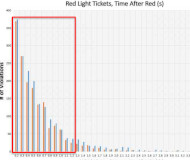3/11/2021
Canada: Yellow Time Increase Slashes Red Light ViolationsNew data show the increased yellow times at two red light camera intersections in Winnipeg, Canada cut violations 75 percent.

A recent increase in yellow time at two Winnipeg, Canada, intersections has already resulted in a substantial drop in the number of red light violations. City leaders made the timing change in September after refusing calls to give drivers more time to stop for more than a decade. As a result, yellow times rose by 0.3 to 0.7 seconds at more than 110 intersections throughout the city.
Instead of a blanket 4.0 second yellow time, locations with 70km/h (43 MPH) speed limits were increased to 4.3 seconds, and intersections with 80km/h (50 MPH) speed limits were increased from 4.0 to 4.7 seconds. Once the additional 0.7 seconds of amber time were applied at the red light camera intersections of Lagimodiere Boulevard at Grassie Boulevard and Bishop Grandin Boulevard at River Road, the number of violations plunged, according to city data.
In the last quarter of 2020 -- the first full quarter with the longer yellows in effect for which city data are available -- the Bishop Grandin intersection saw just 50 red light camera violations. That is down 80 percent from 248 issued in the third quarter and down from the 222 tickets issued in the second quarter while lockdowns were in effect. In the last quarter of 2019, 357 tickets were issued at the location, though traffic levels were higher.
Likewise, the Lagimodiere intersection saw the number of tickets drop from an average of 177 per quarter before the yellow timing increase (during lockdown) compared to 44 in the fourth quarter of 2020 -- a 75 percent drop. In the fourth quarter of 2019, there were 280 tickets issued at the location.
These findings are consistent with a privately funded engineering study in 2017 that found that the greatest number of tickets at the Bishop Grandin intersection went to drivers who missed the signal change by 0.1 to 0.2 seconds (view study in a 1.3mb PDF file). The report recommended the yellow time be increased to 5.2 seconds because doing so would eliminate an estimated 88 percent of violations. In total, 1639 out of 1856 tickets issued at the location in 2016 went to vehicles that entered the intersection less than 1.2 seconds after the signal change.


